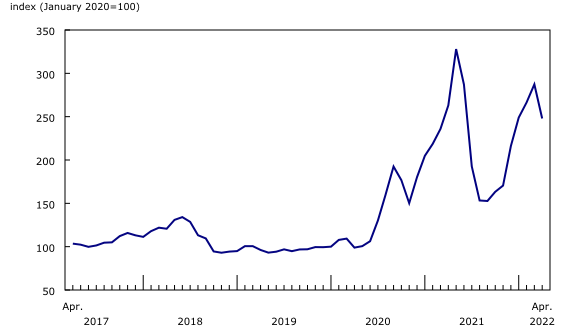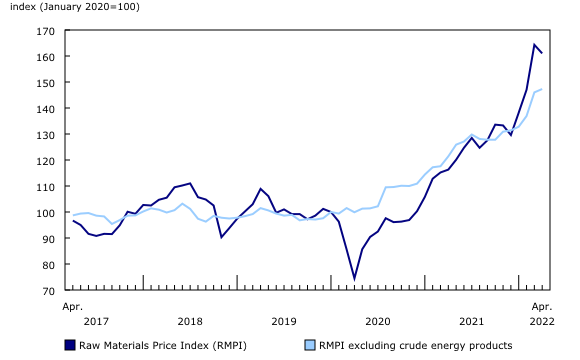OTTAWA
,
May 19, 2022
(press release)
–
Prices of products manufactured in Canada, as measured by the Industrial Product Price Index (IPPI), rose 0.8% month over month in April 2022 and 16.4% year over year. Prices of raw materials purchased by manufacturers operating in Canada, as measured by the Raw Materials Price Index (RMPI), decreased 2.0% on a monthly basis in April 2022 and rose 38.4% year over year. Chart 1: Prices for industrial products increase Industrial Product Price Index Prices for energy and petroleum products (+5.2%) rose for a fourth consecutive month in April 2022. Compared with April 2021, prices were 69.5% higher. The price of jet fuel (+50.5%) had an exceptional increase in April. Canadian prices were affected by a price surge on the US east coast. According to the U.S. Energy Information Administration, in the first week of April, jet fuel inventories in this region fell to their lowest level on record. Prices for diesel fuel were up 4.1%, in part due to low distillate inventories and high overall demand. The price of motor gasoline declined 1.2% in April. The overall increase in the IPPI was largely moderated by lower prices for softwood lumber, which declined 13.7% in April. This is the first monthly decrease for softwood lumber following six months of consecutive price increases. Compared with April 2021, prices were down 5.7%. The drop in prices may have been influenced by higher interest rates in the United States, the primary market for Canadian softwood lumber. According to data from Bankrate, the average interest rate on a 30-year fixed-rate mortgage in the US was 5.11% in April 2022 compared with 4.39% in March. The Bank of Canada also announced an increase in the overnight rate to 1% on April 13, which lead to a rise in the prime rate for variable-rate mortgages. Chart 2: Softwood lumber (except tongue and groove and other edge worked lumber) Primary ferrous metal products rose 3.3%, mainly on higher prices for basic and semi-finished iron or steel products (+3.2%). This increase is partly attributable to limited steel production in China due to COVID-19 pandemic lockdowns. Steel prices were also affected by sanctions on Russian energy and commodities in response to their invasion of Ukraine. On the contrary, prices for primary non-ferrous metal products fell 0.9%, mostly due to price declines for unwrought aluminum and aluminum alloys (-7.9%), and unwrought gold, silver, and platinum group metals and their alloys (-2.7%). Lower prices for aluminum are partially attributable to expectations of slowing global demand. Meat, fish, and dairy products (+2.3%) posted a fourth consecutive monthly increase in April. Price increases were widespread in the meat products subgroup (+3.0%). Prices for fresh and frozen pork was up 6.8%, fresh and frozen beef and veal increased 3.2%, and fresh and frozen poultry of all types was 2.6% higher compared with March. Higher meat prices were partially influenced by elevated input costs, including animal feed and fertilizers. From January to April 2022, prices for animal feed increased by 10.2%, while ammonia and chemical fertilizers were up 7.7%. Prices for fruit, vegetables, feed and other food products were up 1.7% monthly, continuing an upward trend that began in September 2021. Year over year, prices for the group were up 14.2%. Prices for canola oil (+6.2%) and soybean oil (+15.5%) both increased in April. Cooking oil prices have been on the rise globally due to poor harvests leading to tight supplies. The situation has been further exacerbated by the Russian invasion of Ukraine, a major producer of sunflower oil. As cooking oils are often substitutable, increases in the price of one product can spill over and drive up prices of related products. Raw Materials Price Index After three months of consecutive increases, the price of conventional crude oil was down 7.6% in April. In spite of the monthly decline, prices for conventional crude oil were 71.0% higher compared with April 2021. The price of synthetic crude oil (-6.2%) also fell in April. The recent volatility in the crude oil market is mainly due to uncertainty related to the Russian invasion of Ukraine, and its repercussions in terms of petroleum supply. Prices for metal ores, concentrates and scrap were down 1.3% in April. This was mainly driven by a drop in prices for gold, silver, and platinum group metal ores and concentrates (-3.3%), and waste and scrap of metal (-1.9%). Crop products increased 4.0% in April. Price increases within this category were widespread, including canola (+5.2%), corn for grain (+13.6%) and wheat (+5.5%). Chart 3: Prices for raw materials decrease Note to readers With each release, data for the previous six months may have been revised. The indexes are not seasonally adjusted. The IPPI reflects the prices that producers in Canada receive as goods leave the plant gate. The IPPI does not reflect what the consumer pays. Unlike the Consumer Price Index, the IPPI excludes indirect taxes and all costs that occur between the time a good leaves the plant and the time the final user takes possession of the good. This includes transportation, wholesale and retail costs. Canadian producers export many goods. They often indicate their prices in foreign currencies, especially in US dollars, and these prices are then converted into Canadian dollars. This is particularly the case for motor vehicles, pulp and paper products, and wood products. Therefore, fluctuations in the value of the Canadian dollar against its US counterpart affect the IPPI. However, the conversion to Canadian dollars reflects only how respondents provide their prices. This is not a measure that takes into account the full effect of exchange rates. The conversion of prices received in US dollars is based on the average monthly exchange rate established by the Bank of Canada and available in Table 33-10-0163-01 (series v111666275). Monthly and annual variations in the exchange rate, as described in the release, are calculated according to the indirect quotation of the exchange rate (for example, CAN$1 = US$X). The RMPI reflects the prices paid by Canadian manufacturers for key raw materials. Many of those prices are set on the world market. However, as few prices are denominated in foreign currencies, their conversion into Canadian dollars has only a minor effect on the calculation of the RMPI. Products Statistics Canada launched the Producer Price Indexes Portal as part of a suite of portals for prices and price indexes. This webpage provides Canadians with a single point of access to a variety of statistics and measures related to producer prices. The video "Producer price indexes" is available on the Statistics Canada Training Institute webpage. It provides an introduction to Statistics Canada's producer price indexes—what they are, how they are made, and what they are used for. Addition of a new table and additional data Next release Contact information Industry Intelligence Editor's Note: This press release omits select charts and/or marketing language for editorial clarity. Click here to view the full report.
In April, the Industrial Product Price Index (IPPI) rose 0.8% month over month and 16.4% year over year. The monthly increase was mainly due to higher prices for energy and petroleum products (+5.2%). Excluding energy and petroleum products, the IPPI edged up 0.1%.
In April 2022, the Raw Materials Price Index declined 2.0% month over month and rose 38.4% year over year.
The Industrial Product Price Index (IPPI) and the Raw Materials Price Index (RMPI) are available at the Canada level only. Selected commodity groups within the IPPI are also available by region.
The product "Industrial Product Price Index: 2021 Annual Review" is now available. This document is a review of how producer prices, as measured by the IPPI, changed in 2021 compared with 2020. The year 2021 faced a multitude of factors influencing prices, many of which stemmed from the COVID-19 pandemic. Economies reopened slowly as lockdowns were lifted and vaccinations became available, driving up demand.
Effective February 28, 2022, table 18-10-0272-01 has been added to the Statistics Canada website featuring regional indexes for select refined petroleum products. In addition, tables 18-10-0266-01 and 18-10-0268-01 now contain data for select 6- and 7-digit North American Product Classification System series.
The industrial product and raw materials price indexes for May will be released on June 17.
For more information, or to enquire about the concepts, methods or data quality of this release, contact us (toll-free 1-800-263-1136; 514-283-8300; infostats@statcan.gc.ca) or Media Relations (statcan.mediahotline-ligneinfomedias.statcan@statcan.gc.ca).
* All content is copyrighted by Industry Intelligence, or the original respective author or source. You may not recirculate, redistrubte or publish the analysis and presentation included in the service without Industry Intelligence's prior written consent. Please review our terms of use.




